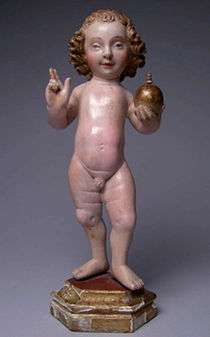Infant Jesus of Mechelen
| Infant Jesus of Mechelen l'Enfant Jesus de Malines | |
|---|---|
 | |
| Location | Paris, France |
| Date | 1500s |
| Witness | Unpublished |
| Type |
Walnut body Polychrome and Gilding Oak wood base |
| Holy See approval | None granted |
| Shrine |
Louvre Museum Department of Sculptures |
The Infant Jesus of Mechelen (French: l'Enfant Jésus de Malines) is an unadorned Roman Catholic 16th-century wooden image depicting the Child Jesus holding a globus cruciger and imparting a priestly Catholic blessing.
Among Santo collectors, the image is often referred to the "fraternal twin" of the Santo Niño de Cebu, with which it shares crucial similarities on posture, gesture, facial expression, and measurement. In September 2009, the image was privately acquired and now housed in the Louvre Museum under security glass. It is displayed naked without any regalia, accessories or vestments formerly associated with other Child Jesus icons.
Description
The image depicts Jesus Christ in his infancy stage. The polychrome materials and characteristics are distinctly from Mechelen, a former part of the Southern Netherlands dating from the early 1500s.[1] The child image alone is made of walnut, carved in a single block piece of wood. The present image is untouched, devoid of any professional restoration work and comprises the following details:
- A cross presumably attached to the Globus Cruciger is missing, and is replaced with a modern finial.
- The uncircumcised phallus of the image is mutilated, unrestored.
- The right forearm of the image is cracked and broken, but was re-attached.
- The feet of the child is attachéd to its hexagonal peana or red lacquered base using two metal rods (similar to Napolitan Jesus images).
- The frontal hexagonal base made of oak wood is adorned with floral and bead carvings.
- The facial resemblance of the image is playfully frolic, with a pinched mouth and pinkish cheekbones.
- The image follows the "Salvator Mundi" style of Christological depiction.
- The curled hair is gilded with pure gold leaf. No evidence of hair wig in place.
Evidence of European colonial characteristics are present on the statue, such as the gilding of the hair using gold leaf while lead paint and oily potassium is used to the skin, similar to the Encarnacion style of sculpting and painting. Further microscopic examination show research that the image was carved in Mechelen, but was probably painted in Brussels then taken to be distributed in the colonized territories of Spain.
Comparison with the Niño de Cebú image
Both the Mechelen statues and the Santo Niño de Cebu are approximately the same height at approximately 30 cm (12 inches) tall, while having similar characteristics such as the standing pose, naked body, hand blessing gesture and golden globes. Assuming that the camera shots are frontally accurate, the faces are almost exactly similar to one another with the following exceptions:
- In published photographs, the Mechelen statue looks frontal and towards in a direct line, while the Cebu statue looks in a downward direction to the devotee
- The Cebu statue's fingers lean to the left, while that of the Mechelen statue points to the right. The original wooden fingers however point upwards when the golden glove is removed.
- The Mechelen statue's hair is sculpted all the way to the knape or close to the neckline, while the Cebu statue looks like it is only up to the earlobes.
Acquisition by the Louvre Museum
The history of acquisition and ownership is unknown and unpublished by the Louvre or Parisian authorities. The image was acquired from a private collector in September 2009 by the Louvre Endowment Fund. It underwent polychrome study, xylology inspection, and radiography to confirm its age and colonial style of authenticity. The image is housed in the Louvre Museum under the Department of Sculptures.
Several pious American Traditionalist Catholics from Texas and New York petitioned the Louvre Endowment fund to purchase and release the custody of the image in 2012 but this petition was not granted. The French magazine La Tribune de l'art featured the image on 16 June 2010 as part of recent Medieval acquisitions by the Louvre Museum.[2]
See also
References
- ↑ "Étude et restauration de l'Enfant Jésus de Malines". Louvre.fr. Retrieved 22 November 2014.
- ↑ "Recent acquisitions in sculpture at the Musée du Louvre". Thearttribune.com. Retrieved 22 November 2014.